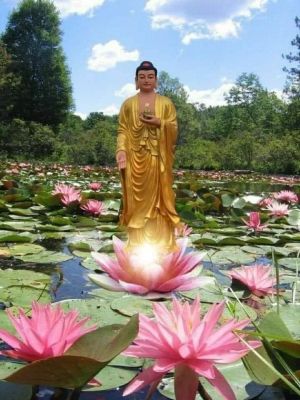The Funeral (sogi) & Other Ceremonies of Remembrance
To bear witness to Amida's guidance to the Pure Land
There are a number of ceremonies in Japanese Buddhism surrounding death and the remembrance of the dead, principally our family members and ancestors. We regard these as a time for the family and/or larger temple community to come together to bear witness to those family and friends who have already entered the Pure Land and to re-affirm our relationship to them and to Amida Buddha through chanting the nembutsu.
Pre-Funeral
The first rites after death are called Death Guidance (makuragyo), in which the precepts (kairitsu) and dharma name (kaimyo) are given to the deceased. The dharma name symbolizes the deceased's final entry into the Buddhist path and his/her Birth in the Pure Land. On the night before the funeral, a wake (otsuya) is held. This is a time for family, friends, and mourners to gather and chant the nembutsu.
During the ceremony, the priest performs a ritual called indo which is a symbolic bearing of witness by the mourners to Amida's leading of the deceased to the Pure Land. During this ritual, two ceremonial torches are used called ako. These "torches of transmigration" symbolize the renunciation of the defiled, human world by the deceased and the embracing of the Pure Land. After the ceremony, mourners take part in a Farewell Rite (kokubetsu-shiki) where they make an incense offering (shoko) while bidding farewell to the deceased and offering condolences to the family. During this time, sutras and the nembutsu are chanted.
At the time of the funeral, a memorial tablet (ihai) is presented to the mourning family to keep on their home altar (butsudan). A copy is almost always kept in the temple as well. The tablet includes the deceased's name, date of death, age, and dharma name. It represents the deceased's attainment of Buddhahood in the Pure Land and offers the family a personal link to the Pure Land for veneration and aspiration. Finally, it is a basic custom in Japanese Buddhism for mourners to offer money to the mourning family to help pay for the funeral. This donation is called a koden.
Post-Funeral
In Japanese Buddhism, and Mahayana Buddhism in general, memorial services to honor the dead are held frequently. The Tsuizen Services (tsuizen kuyo) are the set of initial services for the deceased. The first of which are the Chu-in Services (chu-in kuyo) held weekly until the 49th day after death. These first 49 days are regarded as especially important as they mark the intermediate stage between birth and death (chu-in). In Mahayana Buddhism, in general, it is considered important to hold these services for the benefit of the deceased during this intermediate stage of transmigration.
In the Pure Land tradition, however, since we are assured of immediate birth in the Pure Land upon death through Amida's saving grace, these services are held more to relieve anxiety and to assure the family of the deceased of their loved one's Birth in the Pure Land. The Chu-in Services on the 7th and 49th days after death are considered particularly important. On subsequent yearly anniversaries of the family member's death, further memorial services are held.
These Tsuizen Services are the Anniversary Services (nenkai-hoyo) held on the important anniversaries such as the 1st, 3rd, 7th, 13th, 17th, 23rd, 27th, 33rd, and 50th years. After the 33rd anniversary, the deceased is usually absorbed into the family of ancestral spirits. This is a special time when the family comes to the temple and joins the priest in chanting the nembutsu and holding a special ceremony of remembrance. On the other anniversaries, it is more common for the priest to conduct a short ceremony by himself known as Extended Rites (eitai-kuyo), another of the Tsuizen Services. This literally means the "eternal services" in honor of the dead. Typically, a family makes a donation in the name of the deceased for the temple to continue these rights through the years.
Other Ceremonies of Remembrance
Urabon (also Obon or Bon) is the traditional summer festival held in mid July or mid August in Japan of welcoming home ancestral spirits. It was originally a ceremony of offering food to monks at the end of their rainy season retreat (ango). These dead ancestors are called hotoke-sama, literally "venerable buddhas". This is especially true in the Pure Land tradition where we are assured of birth in the Pure Land and ultimate enlightenment in the next life through Amida's saving grace.
It is most common at Urabon that the priest comes to each family's house to chant the nembutsu and the Pure Land sutras in front of a special table of food offerings (shoryo-dana) made to returning hotoke-sama. This special chanting is called tanagyo. Also during Urabon, individual families will get together to make offerings and prayers at the family grave site.
Segaki was originally a ceremony of offering food to monks for the benefit of dead ancestors who had become hungry ghosts (gaki). It has now become a popular time for the whole community to come together to chant the nembutsu and to make offerings of merit to all ancestors.
Higan means literally "the other shore", that is the other shore of enlightenment which contraststhis worldly shore of birth and death. It is another ceremony to honor our ancestors and to come together to chant the nembutsu. It is held two times a year during the spring and fall equinoxes. At this time, families visit their family graves and also gather at the temple for a communal ceremony.
Source
[[1]]
